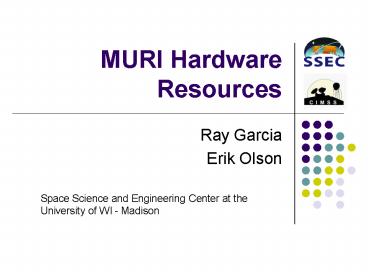MURI Hardware Resources - PowerPoint PPT Presentation
1 / 18
Title:
MURI Hardware Resources
Description:
Presents itself as a single 32-CPU Linux machine ... Stability, documentation, and maturity at time of testing found to be inadequate. ... – PowerPoint PPT presentation
Number of Views:29
Avg rating:3.0/5.0
Title: MURI Hardware Resources
1
MURI Hardware Resources
- Ray Garcia
- Erik Olson
Space Science and Engineering Center at the
University of WI - Madison
2
Resources for Researchers
- CPU cycles
- Memory
- Storage space
- Network
- Software
- Compilers
- Models
- Visualization programs
3
Original MURI hardware
- 16 PIII processors
- Storage server with 0.5 TB
- Gigabit networking
- Purpose
- Provide working environment for collaborative
development. - Enable running of large multiprocessor MM5 model.
- Gain experience working with clustered systems.
4
Capabilities and Limitations
- Successfully ran initial MM5 model runs,
algorithm development (fast model), and modeling
of GIFTS optics (FTS simulator). - MM5 model runs for 140 by 140 domains. One 270 by
270 run with very limited time steps. - OpenPBS system scheduling hundreds of jobs.
- Idle CPU time given to FDTD raytracing.
- Expanded to 28 processors using funding from B.
Baum, IPO, and others. - However, MM5 model runtime limited domain size
and storage space limited number of output time
steps.
5
CY2003 Upgrade
- NASA provided funding for 11 Dual-Pentium4
processor nodes - 4GB DDR-RAM
- 2.4GHz CPUs
- Expressly purposed for running large IHOP field
program simulations (400 by 400 grid point
domain).
6
Cluster Mark 2
- Gains
- Larger scale model runs and instrument
simulations as needed for IHOP - Terabytes of experimental and simulation data
online through NAS, hosted RAID arrays - Limitations to further work at even larger scale
- Interconnect limitations slowed large model runs
- 32-bit memory limitation on huge model set-up
jobs for MM5 and WRF - Increasing number of small storage arrays
7
3 Years of Cluster Work
- Inexpensive
- Adding CPUs to the system
- Costly
- Adding users to the system
- Adding storage to the system
- Easily understood
- Matlab
- Not so well-understood
- Distributed system (computing, storage)
capabilities
8
Along comes DURIP
- H.L.Huang / R.Garcia DURIP proposal awarded May
2004. - Purpose Provide hardware for next generation
research and education programs. - Scope Identify computing and storage systems to
serve the need to expand simulation, algorithm
research, data assimilation and limited
operational product generation experiments.
9
Selecting Computing Hardware
- Cluster options for numerical modeling were
evaluated and found to require significant time
investment. - Purchased SGI Altix fall of 2004 after extensive
test runs with WRF and MM5. - 24 - Itanium2 processors running Linux
- 192GB of RAM
- 5TB of FC/SATA disk
- Recently upgraded to 32 CPUs, 10TB storage.
10
SGI Altix Capabilities
- Large, contiguous RAM allows 1600 by 1600 grid
point domain (gt CONUS area at 4 km res). - Largest so far is 1070 by 1070.
- NUMAlink interconnect provides fast turn around
for model runs - Presents itself as a single 32-CPU Linux
machine - Intel compilers for ease of porting and
optimizing Fortran/C on 32-bit and 64-bit
hardware.
11
Storage Class Home Directory
- Small size for source code (preferably also held
under CVS control) and critical documents - Nightly incremental backups
- Quota enforcement
- Current implementation
- Local disks on cluster head
- Backup by TC
12
Storage Class Workspace
- Optimized for speed
- Automatic flushing of unused files
- No insurance against disk failure
- Users expected to move important results to
Long-term Storage - Current implementation
- RAID5 or RAID0 drive arrays within the cluster
systems
13
Storage Class Long-term
- Large amount of space
- Redundant, preferably back-up to tape
- Managed directory system, preferably with
metadata - Current implementation
- Lots of project-owned NAS devices with partial
redundancy (RAID5) - NFS spaghetti
- Ad-hoc tape backup
14
DURIP phase 2 Storage
- Long term storage scaling and management goals
- Reduce or eliminate NFS spaghetti
- Include hardware phase-in / phase-out strategy in
purchase decision - Acquire the hardware to seed a Storage Area
Network (SAN) in the Data Center, improving
uniformity and scalability - Reduce overhead costs (principally human time)
- Work closely with Technical Computing group on
system setup and operations for a long-term
facility
15
Immediate Options
- Red Hat GFS
- Size limitations and hardware/software
mix-and-match Support costs make up for free
source code. - HP Lustre
- More likely to be a candidate for workspace.
Expensive. - SDSC SRB (Storage Resource Broker)
- Stability, documentation, and maturity at time of
testing found to be inadequate. - Apple Xsan
- Plays well with third-party storage hardware.
Straightforward to configure and maintain.
Affordable.
16
Dataset Storage Purchase Plan
- 64-bit storage servers and meta-data server
- Qlogic Fibre channel switch
- Move data between hosts, drive arrays
- SAN software to provide distributed filesystem
- Focusing on Apple Xsan for 1-3 year span
- Follow up with 1-year assessment with option of
re-competing - Storage arrays
- Competing Apple XRAID, Western Scientific Tornado
17
Target System for 2006
- Scalable dataset storage accessible from
clusters, workstations, and supercomputer - Backup strategy
- Update existing cluster nodes to ROCKS
- Simplified management and improve uniformity
- Proven on other clusters deployed by SSEC
- Retire/repurpose slower cluster nodes
- Reduce bottlenecks to workspace disk
- Improve ease of use and understanding
18
Long-term Goals
- 64-bit shared memory system scaled to huge job
requirements (Altix) - Complementary compute farm migrating to x86-64
(Opteron) hardware - Improved workspace performance
- Scalable storage with full metadata for long-term
and published datasets - Software development tools for multiprocessor
algorithm development

